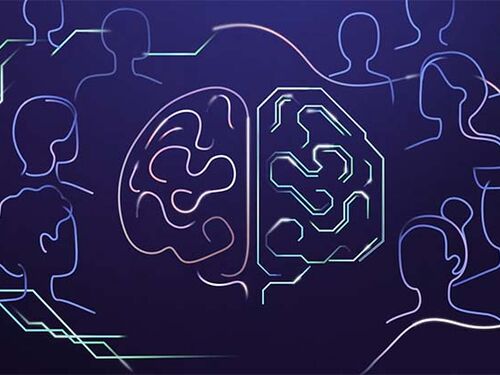A New Era for Classification of Traumatic Brain Injuries
Impact Story
By Sam Gerard
Last update August 19, 2025
Former athlete and Emmy-winning sports reporter Lindsay Simpson suffered a traumatic brain injury in 2018 that nearly took her life. At a recent event held by the National Academies of Sciences, Engineering, and Medicine, she expressed a common refrain among those treated for such injuries — “How are you going to heal when so much energy is spent just trying to prove your diagnosis is real?”
Each year, nearly 3 million people in the U.S. sustain a traumatic brain injury, or TBI. Common causes include falls, sports injuries, car accidents, and military-related incidents. Symptoms can manifest as memory problems, difficulty concentrating, issues in understanding and expressing thoughts, or persistent headaches and fatigue, among other problems.
Typically, patients with a TBI receive a condition diagnosis based on a three-category classification system, labeling their injury as either mild, moderate, or severe. However, a 2022 report from the National Academies found this shorthand can limit care and effective treatment for patients.
For example, someone with severe TBI might have a more favorable outcome than originally expected thanks to the attentive treatment and therapy they received. But a patient diagnosed with mild TBI might have persistent symptoms that worsen because they aren’t connected to follow-up care specialists. Capturing a fuller picture of a patient’s injury and individual risk factors would support more personalized and timely treatments.
According to Donald Berwick, who served as chair of the committee that wrote the 2022 report, no modern treatable disease uses such an imprecise classification system. “In today’s world of precision medicine, one could not imagine classifying cancer as ‘mild, moderate, or severe’ for its diagnosis, treatment, and prognosis,” he said.
A major change is being made to address these shortcomings, however.In May 2025, the National Institute of Neurological Disorders and Stroke’s TBI Classification and Nomenclature Initiative proposed a new approach for how acute TBI is characterized, incorporating recommendations from the 2022 report and ongoing research in areas such as blood-based biomarkers of brain injury. The new, multidimensional “clinical, biomarkers, imaging, and modifiers” (CBI-M) framework provides more accurate and nuanced information by integrating clinical signs and symptoms, blood biomarkers, neuroimaging findings, and individual modifiers that recognize a patient’s injury presentation, lived experience, and other existing health conditions. The aim is to ultimately improve outcomes by providing care that will be responsive to the unique circumstances of every individual with TBI.
What's in a name?
At the event convened by the National Academies’ Forum on Traumatic Brain Injury, scientific experts, patient advocates, federal partners, stakeholders on Capitol Hill, and individuals with lived experience — including Lindsay Simpson — discussed the new TBI categorization and how it can improve care for individuals who experience brain injury.
“[The new CBI-M framework is] the product of collaboration, debate, and most importantly listening — not just to data, but to researchers, clinicians, and people like me who have lived through the messiness of brain injury and recovery,” Simpson remarked.
She expressed relief at how the CBI-M framework would better support patients to overcome administrative obstacles associated with care. Simpson’s TBI was categorized as “mild,” which proved an additional challenge to the recovery process itself. “Insurers push back on my treatment coverage all because of that single word. My fight became not just about my recovery, but it was a fight against the diagnosis itself,” she added.
Walter Koroshetz, director of the National Institute of Neurological Disorders and Stroke, emphasized that broad diagnoses do not effectively serve TBI patients or their health care providers.
“There’s really no magic pill that works in this heterogeneous space,” Koroshetz said. “Instead, what you must do is dissect what’s going on in the brain, what’s wrong, and how to fix it.”
A strong foundation
At an upcoming meeting, members of the TBI Forum will discuss next steps and opportunities to implement and refine the CBI-M framework in clinical research and practice. A major step, according to the report, will include raising awareness among the many professional communities involved in TBI diagnosis and care.
The forum continues to explore scientific, clinical, and policy issues important to the TBI community, such as integrating acute and long-term person- and family-centered care management for TBI patients, and better understanding the immediate needs of caregivers — the nation’s 2.5 million TBI family caregivers report significant stress and limited sources of support, the report says, especially after the first year following their loved one’s injury.
“I think we have a really strong foundation to move forward, thanks to all the people who have worked on this over the years.” Koroshetz concluded.
Watch the event recording and view additional resources.
Featured Publication
Traumatic Brain Injury: A Roadmap for Accelerating Progress
Consensus
·2022
Every community is affected by traumatic brain injury (TBI). Causes as diverse as falls, sports injuries, vehicle collisions, domestic violence, and military incidents can result in injuries across a spectrum of severity and age groups. Just as the many causes of TBI and the people who experience it...
View details


